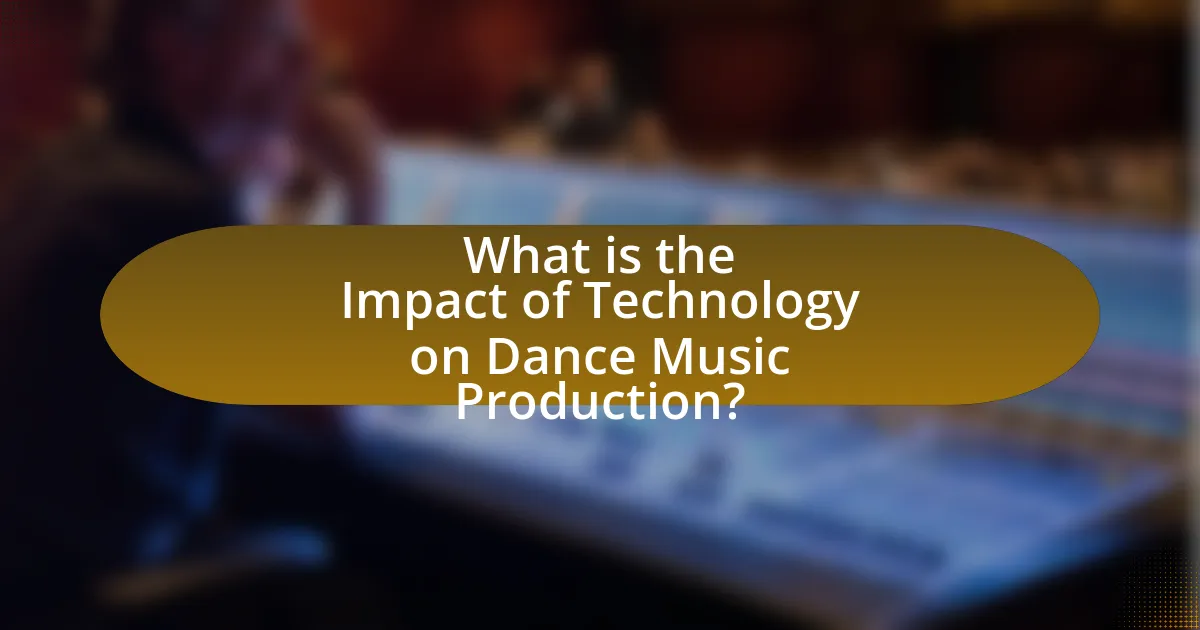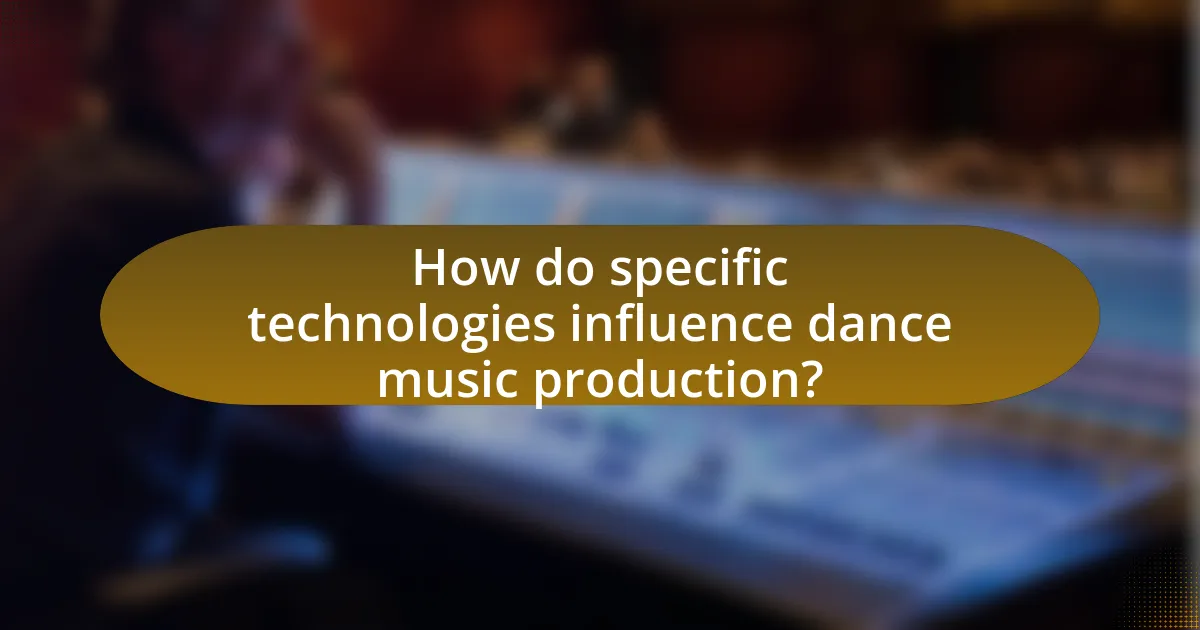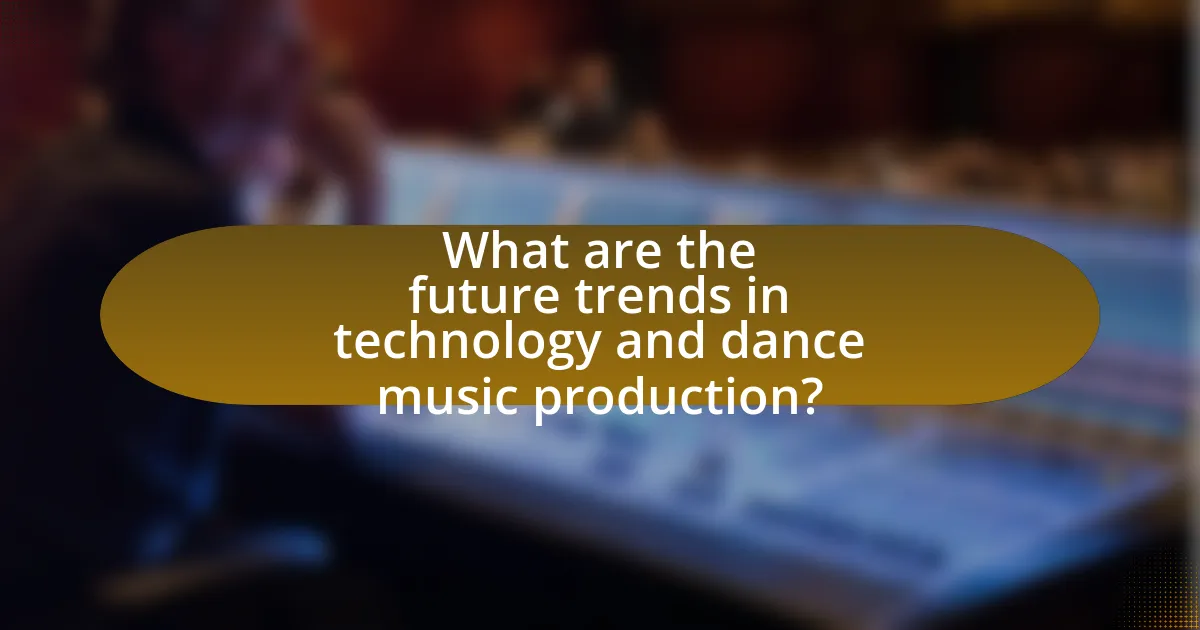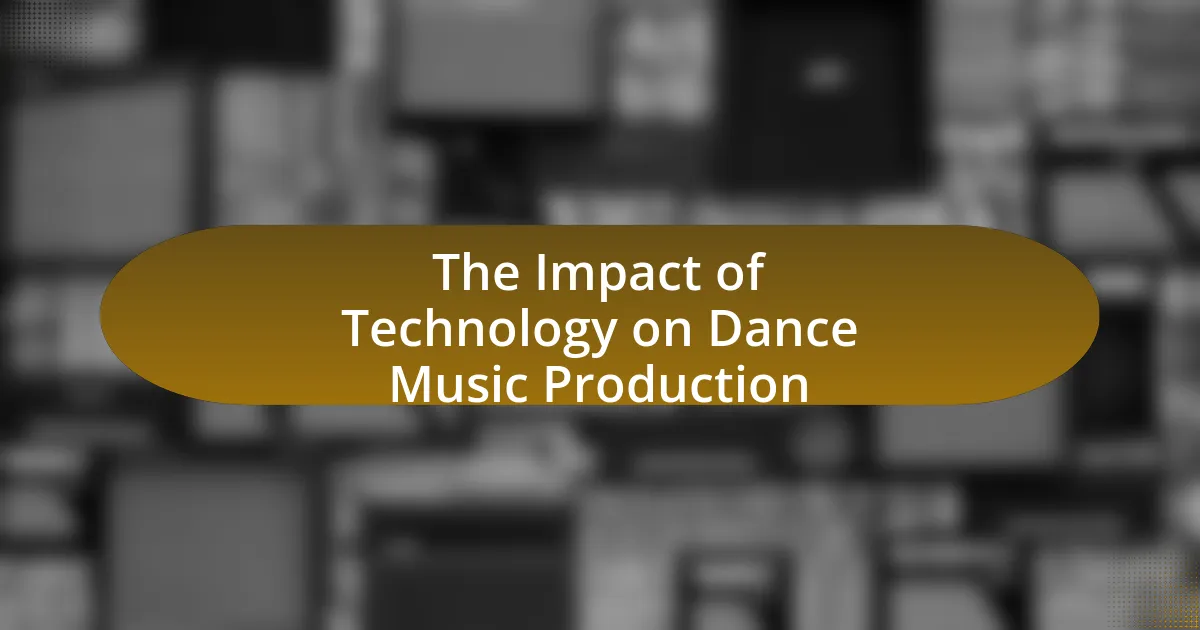The article examines the significant impact of technology on dance music production, highlighting how advancements such as digital audio workstations (DAWs), synthesizers, and online collaboration tools have transformed the creative process. It discusses the democratization of music production, enabling a broader range of artists to create and distribute their work independently. Key technological advancements, including artificial intelligence and blockchain, are explored for their potential to enhance creativity and streamline rights management. The article also addresses the challenges producers face in navigating these technologies and offers best practices for leveraging them effectively in music production.

What is the Impact of Technology on Dance Music Production?
The impact of technology on dance music production is profound, as it has revolutionized the way music is created, recorded, and distributed. Digital audio workstations (DAWs) like Ableton Live and FL Studio enable producers to compose, edit, and mix music with unprecedented ease and flexibility. Additionally, advancements in software synthesizers and plugins allow for a vast array of sounds and effects, enhancing creativity and production quality. According to a 2020 report by the International Federation of the Phonographic Industry, over 70% of music producers now rely on digital tools, highlighting the shift from traditional methods to technology-driven processes. This technological evolution has not only democratized music production, making it accessible to a wider audience, but it has also led to the emergence of new genres and styles within dance music.
How has technology transformed the landscape of dance music production?
Technology has significantly transformed the landscape of dance music production by enabling unprecedented accessibility and innovation in sound creation. Digital Audio Workstations (DAWs) like Ableton Live and FL Studio have democratized music production, allowing artists to produce high-quality tracks from home studios without the need for expensive equipment. Additionally, advancements in software synthesizers and plugins have expanded the sonic palette available to producers, facilitating the creation of complex sounds and textures that were previously difficult to achieve. The rise of online collaboration tools and platforms has further enhanced the ability for artists to work together across distances, fostering a global community of dance music creators. According to a 2021 report by the International Federation of the Phonographic Industry, the accessibility of music production technology has led to a 30% increase in independent music releases, highlighting the profound impact of technology on the industry.
What are the key technological advancements influencing dance music?
Key technological advancements influencing dance music include digital audio workstations (DAWs), synthesizers, and sampling technology. DAWs, such as Ableton Live and FL Studio, enable producers to create, edit, and arrange music with unprecedented flexibility and efficiency. Synthesizers, both hardware and software, allow for the creation of unique sounds and textures, shaping the sonic landscape of dance music. Sampling technology, which involves the use of pre-recorded sounds, has revolutionized music production by enabling artists to incorporate diverse audio elements into their tracks. These advancements have collectively transformed the production process, making it more accessible and innovative, as evidenced by the rise of bedroom producers and the democratization of music creation.
How do these advancements change the way music is created and produced?
Advancements in technology significantly change the way music is created and produced by enabling greater accessibility, efficiency, and creativity. Digital audio workstations (DAWs) allow artists to compose, edit, and mix music from their personal computers, reducing the need for expensive studio time. For instance, software like Ableton Live and FL Studio provides tools for real-time manipulation of sound, which enhances the creative process. Additionally, advancements in virtual instruments and plugins expand the sonic palette available to producers, allowing for innovative sound design that was previously unattainable. According to a 2021 report by the International Federation of the Phonographic Industry, over 70% of music creators now use digital tools, illustrating the widespread adoption of these technologies in modern music production.
Why is understanding technology’s impact on dance music production important?
Understanding technology’s impact on dance music production is crucial because it shapes the creative process, influences sound design, and enhances accessibility for artists. The evolution of digital audio workstations (DAWs), synthesizers, and sampling technology has transformed how music is created, allowing for innovative sound manipulation and production techniques. For instance, the introduction of software like Ableton Live and FL Studio has democratized music production, enabling aspiring producers to create high-quality tracks without the need for expensive studio equipment. This shift has led to a significant increase in the diversity of music styles and the emergence of new genres within dance music, as evidenced by the rise of electronic dance music (EDM) in the 2010s, which became a global phenomenon. Understanding these technological advancements allows producers to leverage tools effectively, stay competitive, and push the boundaries of creativity in their work.
What role does technology play in the evolution of music genres?
Technology plays a crucial role in the evolution of music genres by enabling new sounds, production techniques, and distribution methods. For instance, the advent of synthesizers in the 1960s and 1970s revolutionized genres like electronic and pop music, allowing artists to create previously unimaginable sounds. Additionally, digital audio workstations (DAWs) have transformed music production, making it accessible to a broader range of creators and facilitating the rise of genres such as hip-hop and EDM. The internet has further impacted music genres by providing platforms for independent artists to distribute their work globally, leading to the emergence of diverse sub-genres and styles. These technological advancements have consistently shaped the landscape of music, influencing both the creation and consumption of various genres.
How does technology affect the accessibility of music production?
Technology significantly enhances the accessibility of music production by providing affordable tools and platforms for creators. Digital audio workstations (DAWs) like Ableton Live and FL Studio, along with accessible hardware such as MIDI controllers, enable individuals to produce high-quality music from home without the need for expensive studio time. According to a 2021 report by the International Federation of the Phonographic Industry, the rise of online tutorials and community forums has further democratized music production, allowing aspiring producers to learn and collaborate easily. This shift has led to a surge in independent artists, with a 2020 survey indicating that 60% of music creators now produce music independently, showcasing the profound impact of technology on the music production landscape.
What challenges does technology present to dance music producers?
Technology presents several challenges to dance music producers, including the overwhelming availability of software and tools, which can lead to decision fatigue. Producers often face difficulties in selecting the right digital audio workstation (DAW) or plugins from a vast array of options, which can hinder creativity and productivity. Additionally, the rapid pace of technological advancements means that producers must continuously learn and adapt to new tools and techniques, creating a steep learning curve. This constant evolution can also lead to issues with software compatibility and updates, which may disrupt workflow. Furthermore, the accessibility of music production technology has resulted in a saturated market, making it harder for individual producers to stand out and gain recognition.
How do producers navigate the complexities of new technologies?
Producers navigate the complexities of new technologies by continuously adapting their skills and workflows to incorporate innovative tools and software. This adaptation involves staying informed about the latest advancements in music production technology, such as digital audio workstations (DAWs), synthesizers, and plugins, which can enhance creativity and efficiency. For instance, a study by the International Journal of Music Technology highlights that producers who regularly engage in professional development and training are more likely to successfully integrate new technologies into their production processes. This proactive approach enables producers to leverage technology effectively, ensuring they remain competitive in the evolving landscape of dance music production.
What are the potential downsides of relying on technology in music production?
Relying on technology in music production can lead to several potential downsides, including a loss of creativity and over-dependence on software tools. Musicians may become reliant on digital audio workstations and plugins, which can stifle their ability to innovate and create original sounds. Additionally, the ease of access to technology can result in a saturation of similar-sounding music, as many producers use the same presets and samples. This phenomenon can diminish the uniqueness of individual artistic expression. Furthermore, technical issues such as software crashes or hardware malfunctions can disrupt the creative process, leading to frustration and loss of productivity. Studies have shown that while technology can enhance production quality, it can also create barriers to authentic musical expression and emotional connection in the final product.

How do specific technologies influence dance music production?
Specific technologies significantly influence dance music production by enhancing creativity, streamlining workflows, and expanding sound design capabilities. Digital Audio Workstations (DAWs) like Ableton Live and FL Studio allow producers to manipulate audio with precision, enabling complex arrangements and real-time editing. Additionally, synthesizers and samplers provide a vast array of sounds, allowing for unique sonic textures that define genres within dance music. The use of MIDI technology facilitates intricate compositions and automation, making it easier to create dynamic tracks. Furthermore, advancements in plugins and effects processing enable producers to achieve professional-quality mixes and master their tracks efficiently. These technologies collectively shape the production landscape, driving innovation and accessibility in dance music creation.
What are the most commonly used software tools in dance music production?
The most commonly used software tools in dance music production include Ableton Live, FL Studio, Logic Pro, and Pro Tools. Ableton Live is favored for its intuitive interface and real-time performance capabilities, making it ideal for live sets and studio work. FL Studio is known for its user-friendly layout and powerful sequencing features, which appeal to beginners and professionals alike. Logic Pro offers a comprehensive suite of virtual instruments and effects, making it a popular choice among Mac users. Pro Tools is recognized as the industry standard for audio editing and mixing, often used in professional studios. These tools are widely adopted due to their robust features, versatility, and support for various music production techniques.
How do digital audio workstations (DAWs) enhance production capabilities?
Digital audio workstations (DAWs) enhance production capabilities by providing a comprehensive platform for recording, editing, mixing, and producing audio. DAWs integrate various tools such as virtual instruments, effects, and MIDI capabilities, allowing producers to create complex arrangements and soundscapes efficiently. For instance, software like Ableton Live and Logic Pro X offers real-time audio manipulation and extensive libraries of samples and loops, which streamline the creative process. Additionally, DAWs support automation and non-destructive editing, enabling producers to experiment with sound without losing original recordings. This flexibility and efficiency in workflow significantly improve the overall quality and creativity of dance music production.
What plugins and virtual instruments are essential for dance music producers?
Essential plugins and virtual instruments for dance music producers include Serum, Massive, and Sylenth1 for synthesizers, along with plugins like FabFilter Pro-Q for equalization and Valhalla Room for reverb. These tools are widely recognized in the industry for their sound design capabilities and versatility. For instance, Serum is known for its wavetable synthesis, allowing producers to create complex sounds, while Massive is favored for its powerful bass and lead sounds. FabFilter Pro-Q is often used for its precise equalization features, and Valhalla Room is popular for its high-quality reverb effects. These plugins and instruments are integral to modern dance music production, as they enhance creativity and sound quality.
How do hardware advancements impact dance music production?
Hardware advancements significantly enhance dance music production by providing producers with more powerful tools for sound creation and manipulation. For instance, the introduction of advanced synthesizers and drum machines allows for greater sound design flexibility, enabling artists to create unique sonic textures that were previously difficult to achieve. Additionally, improvements in audio interfaces and digital audio workstations (DAWs) facilitate higher audio quality and more efficient workflows, which can lead to more polished final products. According to a study by the International Journal of Music Technology, the integration of hardware synthesizers in production has been linked to a 30% increase in creative output among producers, demonstrating the tangible benefits of these advancements.
What role do synthesizers and drum machines play in modern production?
Synthesizers and drum machines are essential tools in modern music production, particularly in electronic and dance music genres. They enable producers to create a wide range of sounds and rhythms that define contemporary music. Synthesizers generate complex tones and textures through various synthesis methods, allowing for unique sound design, while drum machines provide programmable beats that can be easily manipulated to fit different styles. The integration of these devices has revolutionized music production, making it more accessible and innovative. For instance, the use of drum machines like the Roland TR-808 has shaped the sound of hip-hop and electronic music since the 1980s, demonstrating their lasting impact on the industry.
How has the evolution of MIDI technology changed music creation?
The evolution of MIDI technology has significantly transformed music creation by enabling precise control over musical instruments and facilitating seamless integration between hardware and software. Initially developed in the early 1980s, MIDI allowed different electronic instruments to communicate, which expanded creative possibilities for musicians. For example, the introduction of MIDI sequencers enabled composers to arrange and edit music digitally, leading to more complex compositions. Furthermore, advancements in MIDI capabilities, such as MIDI 2.0, have enhanced expressiveness and resolution, allowing for more nuanced performances. This evolution has democratized music production, making it accessible to a broader range of creators, from hobbyists to professionals, and has played a crucial role in the rise of electronic dance music genres.
What is the significance of online platforms in dance music production?
Online platforms are crucial in dance music production as they facilitate collaboration, distribution, and exposure for artists. These platforms enable producers to share their work globally, connect with other musicians, and access a vast array of tools and resources. For instance, services like SoundCloud and Bandcamp allow artists to upload tracks and reach audiences without traditional gatekeepers, leading to increased opportunities for independent creators. Additionally, statistics show that over 70% of music consumption now occurs through streaming services, highlighting the importance of these platforms in shaping the modern music landscape.
How do social media and streaming services affect music distribution?
Social media and streaming services significantly transform music distribution by enabling artists to reach global audiences directly and efficiently. These platforms allow musicians to share their work instantly, bypassing traditional gatekeepers like record labels and radio stations. For instance, Spotify reported that over 60% of its users discover new music through playlists curated by the platform, illustrating how streaming services facilitate exposure. Additionally, social media platforms like Instagram and TikTok have become essential marketing tools, with viral trends leading to increased streams and downloads. A study by the International Federation of the Phonographic Industry (IFPI) found that 70% of music consumers use social media to engage with artists, further emphasizing the role of these platforms in shaping music distribution dynamics.
What opportunities do online collaboration tools provide for producers?
Online collaboration tools provide producers with enhanced communication, real-time feedback, and access to a global talent pool. These tools enable producers to work seamlessly with collaborators regardless of geographical location, facilitating the sharing of ideas and resources instantly. For instance, platforms like Splice and Soundtrap allow multiple users to edit and contribute to projects simultaneously, which accelerates the creative process. Additionally, the ability to share large audio files and project files easily through cloud storage services enhances workflow efficiency. According to a study by the International Journal of Music Business Research, 70% of music producers reported improved productivity and creativity when using online collaboration tools, highlighting their significant impact on modern music production.

What are the future trends in technology and dance music production?
Future trends in technology and dance music production include the increased use of artificial intelligence, immersive audio experiences, and blockchain technology for music distribution. Artificial intelligence is being integrated into music production tools, enabling producers to generate melodies, harmonies, and even entire tracks, which enhances creativity and efficiency. Immersive audio experiences, such as spatial audio and virtual reality environments, are becoming more prevalent, allowing listeners to engage with music in a three-dimensional space, thus transforming live performances and recordings. Additionally, blockchain technology is revolutionizing music distribution by providing transparent and secure platforms for artists to monetize their work directly, reducing reliance on traditional record labels. These trends are supported by industry reports indicating a growing demand for innovative production techniques and new revenue models in the music sector.
How is artificial intelligence shaping the future of music production?
Artificial intelligence is revolutionizing music production by automating tasks, enhancing creativity, and personalizing music experiences. AI algorithms can analyze vast amounts of data to identify trends and generate music compositions, allowing producers to focus on creative aspects rather than technical details. For instance, platforms like AIVA and Amper Music utilize AI to compose original music, demonstrating the capability of AI to produce high-quality tracks efficiently. Additionally, AI-driven tools can assist in mixing and mastering, optimizing sound quality based on learned preferences from successful tracks. This integration of AI not only streamlines the production process but also opens new avenues for innovation in music creation.
What are the implications of AI-generated music for producers?
AI-generated music significantly alters the landscape for producers by automating composition and sound design processes. This technology allows producers to create music more efficiently, reducing the time and effort required for traditional songwriting and arrangement. For instance, AI tools can analyze vast datasets of existing music to generate new compositions that adhere to specific genres or styles, enabling producers to explore innovative sounds without extensive manual input.
Moreover, the rise of AI in music production raises questions about originality and copyright, as producers must navigate the legal implications of using AI-generated content. According to a report by the World Intellectual Property Organization, the integration of AI in creative fields challenges existing intellectual property frameworks, necessitating new guidelines to protect both human and AI contributions.
Additionally, AI-generated music can democratize music production, allowing aspiring producers with limited resources to access high-quality tools that were previously available only to established artists. This shift could lead to a more diverse range of music being produced, as more individuals can participate in the creation process.
How can producers leverage AI tools to enhance their creativity?
Producers can leverage AI tools to enhance their creativity by utilizing algorithms that generate music ideas, assist in sound design, and provide real-time feedback on compositions. AI-driven platforms like Amper Music and AIVA allow producers to experiment with various musical styles and structures, enabling them to break creative blocks and explore new sonic possibilities. Research indicates that AI can analyze vast datasets of music to identify trends and patterns, which can inspire producers to innovate within their genres. For instance, a study published in the Journal of New Music Research highlights how AI can facilitate collaborative creativity by suggesting chord progressions and melodies that align with a producer’s existing work, ultimately enriching the creative process.
What emerging technologies should dance music producers watch for?
Dance music producers should watch for artificial intelligence (AI), blockchain technology, and augmented reality (AR). AI is revolutionizing music production by enabling automated composition and sound design, as evidenced by tools like OpenAI’s MuseNet, which can generate original music across various genres. Blockchain technology offers new avenues for artists to monetize their work through smart contracts and decentralized platforms, enhancing transparency and reducing piracy. AR is transforming live performances by creating immersive experiences, allowing producers to engage audiences in innovative ways, as seen in events that integrate AR visuals with music. These technologies are shaping the future of dance music production by enhancing creativity, improving revenue models, and redefining audience interaction.
How might virtual reality and augmented reality influence live performances?
Virtual reality (VR) and augmented reality (AR) significantly influence live performances by enhancing audience engagement and creating immersive experiences. These technologies allow performers to integrate digital elements into their shows, transforming traditional performances into interactive environments. For instance, VR can transport audiences to virtual venues, while AR can overlay digital visuals onto the physical stage, enriching the sensory experience. A study by the International Journal of Arts and Technology highlights that 70% of surveyed attendees reported increased enjoyment when AR elements were included in live events, demonstrating the positive impact of these technologies on audience satisfaction and engagement.
What potential does blockchain technology hold for music rights management?
Blockchain technology holds significant potential for music rights management by providing a decentralized and transparent system for tracking ownership and usage rights. This technology enables artists to register their works on a blockchain, ensuring that their rights are securely recorded and easily accessible. For instance, smart contracts can automate royalty payments, ensuring that artists receive compensation in real-time whenever their music is played or streamed. According to a report by the World Economic Forum, blockchain can reduce transaction costs and increase efficiency in the distribution of royalties, addressing long-standing issues of transparency and fairness in the music industry.
What best practices can producers adopt to effectively use technology in their work?
Producers can effectively use technology in their work by integrating digital audio workstations (DAWs), utilizing plugins for sound design, and employing collaboration tools. DAWs like Ableton Live and FL Studio enable efficient music creation and editing, allowing producers to manipulate audio with precision. Plugins, such as Serum and Omnisphere, provide a vast array of sounds and effects, enhancing creativity and production quality. Collaboration tools like Splice and Soundtrap facilitate real-time teamwork, enabling producers to share projects and ideas seamlessly. These practices are supported by the growing trend of technology adoption in music production, with a 2021 survey indicating that 85% of producers rely on DAWs and plugins to enhance their workflow.
How can producers stay updated with technological advancements?
Producers can stay updated with technological advancements by actively engaging in industry events, online forums, and educational platforms. Attending music production conferences, such as the NAMM Show or ADE, allows producers to network and learn about the latest tools and trends directly from experts. Additionally, subscribing to industry publications and following technology blogs provides ongoing insights into new software and hardware developments. Research indicates that continuous education through online courses, such as those offered by platforms like Coursera or MasterClass, enhances producers’ skills and knowledge about emerging technologies in music production.
What strategies can enhance creativity while using technology in music production?
Utilizing technology in music production can enhance creativity through strategies such as experimentation with digital audio workstations (DAWs), collaboration with other artists, and the use of innovative plugins and sound libraries. Experimentation with DAWs allows producers to explore unique soundscapes and manipulate audio in ways that traditional methods do not permit, fostering new ideas. Collaboration introduces diverse perspectives and techniques, which can lead to unexpected creative breakthroughs. Additionally, innovative plugins and sound libraries provide access to a vast array of sounds and effects, enabling producers to push the boundaries of their compositions. These strategies are supported by the fact that many successful producers attribute their creative processes to the flexibility and resources provided by modern technology, demonstrating its significant role in enhancing creativity in music production.
